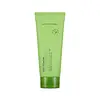What's inside
What's inside
 Key Ingredients
Key Ingredients

 Benefits
Benefits

 Concerns
Concerns

 Ingredients Side-by-side
Ingredients Side-by-side

Water
Skin ConditioningStearic Acid
CleansingMyristic Acid
CleansingPotassium Hydroxide
BufferingLauric Acid
CleansingButylene Glycol
HumectantGlyceryl Stearate
EmollientLauramide DEA
PEG-100 Stearate
Potassium Cocoyl Glycinate
Salicylic Acid
MaskingCocamidopropyl Betaine
CleansingOlea Europaea Fruit Oil
MaskingDisodium EDTA
Lavandula Angustifolia Oil
MaskingPinus Sylvestris Leaf Oil
MaskingCananga Odorata Flower Oil
MaskingRosmarinus Officinalis Leaf Oil
MaskingPollen Extract
EmollientPelargonium Graveolens Flower Oil
MaskingOriganum Vulgare Leaf Extract
Skin ConditioningMelaleuca Alternifolia Leaf Oil
AntioxidantSalix Alba Bark Extract
AstringentChamaecyparis Obtusa Leaf Extract
Skin ConditioningPortulaca Oleracea Extract
Skin ConditioningScutellaria Baicalensis Root Extract
AstringentLactobacillus/Soybean Ferment Extract
Skin ConditioningCinnamomum Cassia Bark Extract
MaskingPhenoxyethanol
PreservativeAscorbic Acid
AntioxidantPolydecene
Skin ConditioningCamellia Japonica Flower Extract
Emollient1,2-Hexanediol
Skin ConditioningSqualane
EmollientViscum Album Fruit Extract
SoothingAlcohol
AntimicrobialTerminalia Chebula Fruit Extract
Skin ConditioningCaesalpinia Sappan Bark Extract
Skin ConditioningMagnolia Obovata Bark Extract
Skin ConditioningBee Venom
AstringentLecithin
EmollientHydroxylauric Acid
Skin ConditioningWater, Stearic Acid, Myristic Acid, Potassium Hydroxide, Lauric Acid, Butylene Glycol, Glyceryl Stearate, Lauramide DEA, PEG-100 Stearate, Potassium Cocoyl Glycinate, Salicylic Acid, Cocamidopropyl Betaine, Olea Europaea Fruit Oil, Disodium EDTA, Lavandula Angustifolia Oil, Pinus Sylvestris Leaf Oil, Cananga Odorata Flower Oil, Rosmarinus Officinalis Leaf Oil, Pollen Extract, Pelargonium Graveolens Flower Oil, Origanum Vulgare Leaf Extract, Melaleuca Alternifolia Leaf Oil, Salix Alba Bark Extract, Chamaecyparis Obtusa Leaf Extract, Portulaca Oleracea Extract, Scutellaria Baicalensis Root Extract, Lactobacillus/Soybean Ferment Extract, Cinnamomum Cassia Bark Extract, Phenoxyethanol, Ascorbic Acid, Polydecene, Camellia Japonica Flower Extract, 1,2-Hexanediol, Squalane, Viscum Album Fruit Extract, Alcohol, Terminalia Chebula Fruit Extract, Caesalpinia Sappan Bark Extract, Magnolia Obovata Bark Extract, Bee Venom, Lecithin, Hydroxylauric Acid
Water
Skin ConditioningGlycerin
HumectantButylene Glycol
HumectantCocamidopropyl Betaine
CleansingSodium Myristoyl Glutamate
CleansingGlycol Distearate
EmollientSodium Cocoyl Glycinate
CleansingCocamide Methyl Mea
Acrylates Copolymer
Citric Acid
BufferingSodium Chloride
MaskingPEG-14m
Emulsion StabilisingNiacinamide
SmoothingEuglena Gracilis Extract
Skin Conditioning1,2-Hexanediol
Skin ConditioningXanthan Gum
EmulsifyingSodium Hyaluronate
HumectantHyaluronic Acid
HumectantCaprylyl Glycol
EmollientGlucose
HumectantTocopherol
AntioxidantChondrus Crispus Extract
Skin ConditioningHydrolyzed Hyaluronic Acid
HumectantHydrolyzed Sodium Hyaluronate
Skin ConditioningHydroxypropyltrimonium Hyaluronate
Potassium Hyaluronate
Skin ConditioningSodium Acetylated Hyaluronate
HumectantSodium Hyaluronate Crosspolymer
HumectantPhenoxyethanol
PreservativeChlorphenesin
AntimicrobialPotassium Sorbate
PreservativeSodium Benzoate
MaskingWater, Glycerin, Butylene Glycol, Cocamidopropyl Betaine, Sodium Myristoyl Glutamate, Glycol Distearate, Sodium Cocoyl Glycinate, Cocamide Methyl Mea, Acrylates Copolymer, Citric Acid, Sodium Chloride, PEG-14m, Niacinamide, Euglena Gracilis Extract, 1,2-Hexanediol, Xanthan Gum, Sodium Hyaluronate, Hyaluronic Acid, Caprylyl Glycol, Glucose, Tocopherol, Chondrus Crispus Extract, Hydrolyzed Hyaluronic Acid, Hydrolyzed Sodium Hyaluronate, Hydroxypropyltrimonium Hyaluronate, Potassium Hyaluronate, Sodium Acetylated Hyaluronate, Sodium Hyaluronate Crosspolymer, Phenoxyethanol, Chlorphenesin, Potassium Sorbate, Sodium Benzoate
Ingredients Explained
These ingredients are found in both products.
Ingredients higher up in an ingredient list are typically present in a larger amount.
1,2-Hexanediol is a synthetic liquid and another multi-functional powerhouse.
It is a:
- Humectant, drawing moisture into the skin
- Emollient, helping to soften skin
- Solvent, dispersing and stabilizing formulas
- Preservative booster, enhancing the antimicrobial activity of other preservatives
Butylene Glycol (or BG) is used within cosmetic products for a few different reasons:
Overall, Butylene Glycol is a safe and well-rounded ingredient that works well with other ingredients.
Though this ingredient works well with most skin types, some people with sensitive skin may experience a reaction such as allergic rashes, closed comedones, or itchiness.
Learn more about Butylene GlycolCocamidopropyl Betaine is a fatty acid created by mixing similar compounds in coconut oil and dimethylaminopropylamine, a compound with two amino groups.
This ingredient is a surfactant and cleanser. It helps gather the dirt, pollutants, and other impurities in your skin to be washed away. It also helps thicken a product and make the texture more creamy.
Being created from coconut oil means Cocamidopropyl Betaine is hydrating for the skin.
While Cocamidopropyl Betaine was believed to be an allergen, a study from 2012 disproved this. It found two compounds in unpure Cocamidopropyl Betaine to be the irritants: aminoamide and 3-dimethylaminopropylamine. High-grade and pure Cocamidopropyl Betaine did not induce allergic reactions during this study.
Learn more about Cocamidopropyl BetainePhenoxyethanol is a preservative that has germicide, antimicrobial, and aromatic properties. Studies show that phenoxyethanol can prevent microbial growth. By itself, it has a scent that is similar to that of a rose.
It's often used in formulations along with Caprylyl Glycol to preserve the shelf life of products.
Water. It's the most common cosmetic ingredient of all. You'll usually see it at the top of ingredient lists, meaning that it makes up the largest part of the product.
So why is it so popular? Water most often acts as a solvent - this means that it helps dissolve other ingredients into the formulation.
You'll also recognize water as that liquid we all need to stay alive. If you see this, drink a glass of water. Stay hydrated!
Learn more about Water